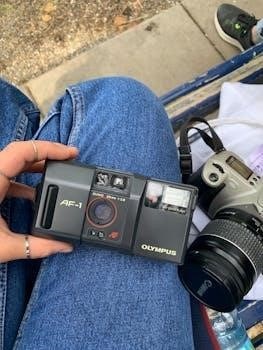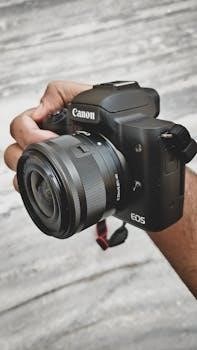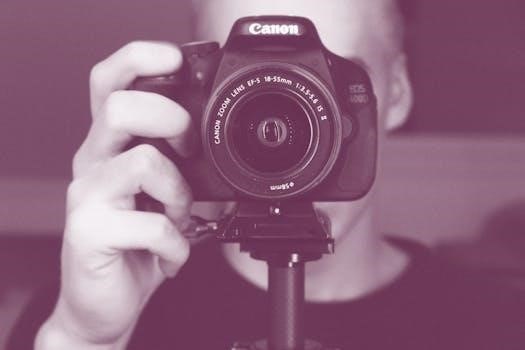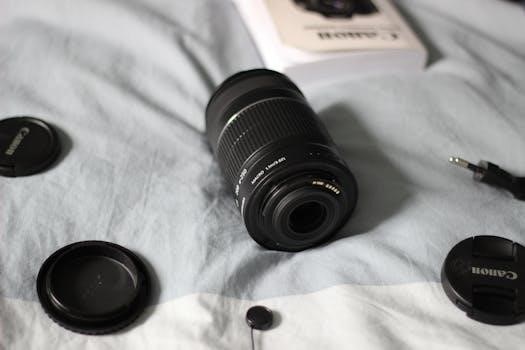is canon ae-1 full manual
Is Canon AE-1 Full Manual?
The Canon AE-1 offers a blend of automatic and manual controls, but it’s not a fully manual camera in the traditional sense. It provides shutter priority automatic exposure, allowing users to select a shutter speed while the camera sets the aperture. However, it also includes a manual mode where the aperture and shutter can be set independently. This is indicated by an ‘M’ appearing in the viewfinder. The AE-1 also has a bulb setting for very long exposures.
The Canon AE-1, a popular 35mm film SLR camera, offers a variety of exposure modes designed to cater to different photographic needs and skill levels. These modes range from fully automatic settings to more hands-on, manual control, allowing photographers to adapt to various shooting scenarios. The camera’s primary modes include shutter-priority automatic exposure (AE), where the photographer selects the shutter speed and the camera automatically chooses the appropriate aperture. Additionally, the AE-1 features a programmed AE mode, which automatically sets both shutter speed and aperture. For more creative control, the AE-1 also allows for manual setting of both aperture and shutter speed. This range of modes makes the AE-1 a versatile tool for both beginners learning the ropes of photography and more experienced photographers seeking to fine-tune their shots. The inclusion of a ‘B’ (bulb) setting enables photographers to make long exposures for creative effects, further enhancing the camera’s capabilities. Understanding these exposure modes is essential for mastering the Canon AE-1.
Understanding Manual Mode on the Canon AE-1
Manual mode on the Canon AE-1 provides photographers with complete control over exposure settings. Unlike automatic modes where the camera makes exposure decisions, in manual mode, you set both the aperture and the shutter speed. This allows for creative freedom and precise adjustments to achieve the desired effect. When you switch to manual mode, an ‘M’ appears in the viewfinder to indicate that you are controlling the exposure. This mode is ideal when you need to override the camera’s automatic settings, such as in challenging lighting conditions or for specific creative outcomes, such as capturing motion or depth of field. Manual mode requires a good understanding of the relationship between aperture, shutter speed, and ISO to achieve a well-exposed image. It is essential to learn how to use the camera’s light meter to guide your settings and to practice making adjustments until you understand how to achieve the desired result.

Shutter Priority Mode on the AE-1
The Canon AE-1’s shutter priority mode, often labeled as “Tv” or “Time value” on some cameras, is a semi-automatic mode where the photographer selects the shutter speed, and the camera automatically sets the corresponding aperture. This mode is particularly useful for controlling the appearance of motion in photographs. By selecting a faster shutter speed, you can freeze action, while a slower speed can blur movement to convey a sense of speed or fluidity. The camera’s internal metering system assesses the light and chooses the aperture setting to ensure proper exposure based on the selected shutter speed. This mode allows the user to focus on capturing the desired motion effects, without needing to manually change both shutter speed and aperture settings simultaneously. It’s a great mode for action photography, sports, or any situation where motion is a key element in the image. Understanding how shutter priority affects exposure is important for achieving the desired effect.
Aperture Control in Manual Mode
In the Canon AE-1’s manual mode, you have direct control over the aperture setting, which is crucial for managing both exposure and depth of field. The aperture, often represented by f-numbers (like f/2.8, f/5.6, f/16), determines how much light passes through the lens. A wider aperture (smaller f-number) allows more light to hit the sensor, which is useful in low-light situations. It also creates a shallower depth of field, blurring the background and making the subject stand out. Conversely, a smaller aperture (larger f-number) allows less light and increases the depth of field, keeping more of the scene in focus. Adjusting the aperture manually allows you to make creative decisions about the appearance of your photographs, beyond just achieving proper exposure. This control is essential for achieving specific aesthetic effects in your images, giving you complete control over sharpness and blur.
Using the ‘B’ (Bulb) Setting for Long Exposures
The ‘B’ or Bulb setting on the Canon AE-1 is a specialized mode designed for capturing extremely long exposures, typically longer than the camera’s standard shutter speed settings. When the shutter speed dial is set to ‘B’, the shutter remains open for as long as the shutter release button is pressed down. This feature is particularly useful for photographing nighttime scenes, light trails, or any situation where extended exposure times are necessary to gather enough light. To use the Bulb mode effectively, it’s crucial to have a stable platform, like a tripod, to prevent camera shake during the long exposure. Additionally, a remote shutter release can further minimize camera movement, ensuring sharp and clear images. The ‘B’ setting allows for creative explorations with time, capturing motion and light in unique ways, and is an essential tool for any photographer venturing into long-exposure photography. It’s also useful for very low light situations where the camera’s longest shutter speed isn’t long enough.
Programmed AE Mode on the AE-1
The Canon AE-1, while known for its shutter priority and manual capabilities, also features a Programmed AE mode. This mode offers a convenient, automated way to capture images by having the camera choose both the aperture and shutter speed. When in Program mode, the camera analyzes the scene’s light and selects what it determines to be the optimal exposure settings, freeing the photographer from having to make these decisions. To engage Program mode, the user sets the aperture ring to ‘A’ and the shutter speed dial to ‘Program’. A ‘P’ indicator will then illuminate in the viewfinder. This mode is particularly useful in situations where speed is necessary or when a photographer wants a reliable automatic setting. The camera’s programmed settings are based on a pre-set algorithm, which covers a range from EV1 (f/1.4, 1 second) to EV18 (F/16, 1/1000) at ASA 100. While the AE-1 doesn’t have full program control, this mode provides a handy alternative to full manual mode.

How to Set Manual Mode on the AE-1
To engage manual mode on the Canon AE-1, the user must make adjustments to both the aperture and shutter speed settings independently. This contrasts with the camera’s automatic modes, where it handles some or all of these settings. Firstly, locate the aperture ring on the lens and rotate it to the desired f-stop. Next, use the shutter speed dial on the camera body to select a specific shutter speed. By setting both the aperture and shutter speed, the user takes full control of the exposure. When in manual mode, an ‘M’ is displayed in the viewfinder, confirming that the camera is no longer automatically adjusting these settings. It’s crucial to understand the relationships between aperture, shutter speed, and ISO to achieve the desired effect; Manual mode requires the user to have a good grasp of exposure principles and is typically employed when a greater level of creative control is required. The AE-1 does not have a fully manual mode by itself, only with these manual adjustments.
The Viewfinder Indicator for Manual Mode
When the Canon AE-1 is set to manual exposure mode, a distinct indicator appears within the viewfinder. This indicator is a simple yet crucial visual cue that the camera is operating outside its automatic settings. Specifically, a letter ‘M’ will illuminate in the viewfinder. This ‘M’ serves as a clear and immediate confirmation to the user that they are now in control of both the aperture and shutter speed. The presence of the ‘M’ means that the camera’s light meter will still be active, providing a reading, but the user will be responsible for adjusting the lens and shutter to get the correct exposure. This indicator is essential because it prevents confusion between the automatic and manual modes. Without it, the user may think the camera is making automatic adjustments and get unexpected exposures. It is important to check this ‘M’ to make sure you are in the right shooting mode. This makes the viewfinder indicator a very important tool when shooting in manual.

Limitations of the AE-1’s Manual Control
While the Canon AE-1 offers a manual mode, it’s important to understand its limitations compared to a fully manual camera. The AE-1’s manual mode, while giving the user aperture and shutter control, still relies on the camera’s internal light meter for guidance. Unlike some classic fully manual cameras, the AE-1 does not have the ability to fully disconnect the camera’s meter and shoot without its input. It is there to help you achieve the exposure but not control it. The camera will not adjust the aperture setting as you change the shutter speed. The manual mode is not as simple as setting the aperture and the shutter speed, and it will need to be done in combination with the light meter. Also, with non-FD lenses, the AE-1 requires stopped-down metering. This method can be slower than the full aperture metering with FD lenses. The AE-1 also does not have a fully mechanical shutter, and therefore requires batteries to operate, even in manual mode. This is a limitation for those who like to shoot without electronics.
Lenses Compatible with Manual Metering
The Canon AE-1 is designed to work with a variety of lenses, though their compatibility with the camera’s manual metering system varies. The AE-1 supports Canon FD lenses, which are designed for full-aperture metering. This means that the camera’s light meter can measure the light at the widest aperture, making it easier to compose and focus before taking the shot. However, the AE-1 can also be used with older Canon FL lenses and other non-FD lenses. These lenses require stopped-down metering. With the stopped-down metering process, the user has to close the lens aperture manually to the desired f-stop before the light meter can take a reading. While the AE-1 can accommodate these lenses, the manual metering process is less convenient than using FD lenses. It is important to note that the user has to manually set both aperture and shutter speed with all the lenses for the manual mode.

Canon AE-1⁚ Full Creative Control
Despite not being a fully manual camera, the Canon AE-1 offers substantial creative control to photographers. Its shutter-priority automatic exposure mode allows the user to dictate the motion effects in their photos. By selecting a specific shutter speed, the photographer can freeze action or create motion blur. Further, the manual mode allows photographers to set both the aperture and shutter speed, granting complete control over exposure. This is particularly useful for situations where the automatic metering system might not accurately represent the desired outcome. The ‘B’ (bulb) setting also gives greater creative control, enabling long exposures and capturing unique light effects; This mix of automatic and manual options enables users to explore a wide range of creative techniques. The AE-1 allows for both ease of use and artistic freedom.